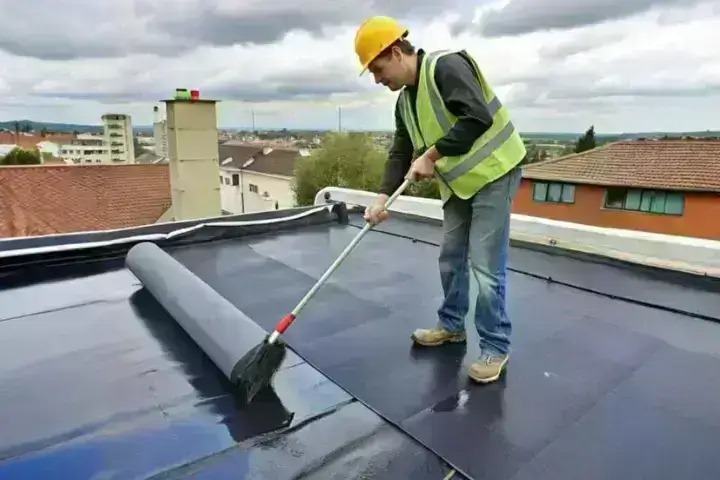Every strong building begins with a strong foundation — but maintaining that strength requires protection against the elements. Among all environmental factors, water is the most persistent and destructive. From rainfall and floods to humidity and leaks, moisture can silently deteriorate a building over time.
At Gemcon Engineering, we consider waterproofing as a fundamental step in construction and renovation. It’s not a luxury or an optional feature — it’s an investment in durability, safety, and property value.
Understanding Waterproofing
Waterproofing is the process of applying protective layers, sealants, membranes, or chemical treatments to prevent water from penetrating into structural components. It is not limited to basements or roofs; waterproofing applies to:
- Foundations and basements to stop groundwater seepage.
- Terraces and roofs to protect against rainwater pooling.
- Bathrooms, kitchens, and wet rooms where constant exposure to water occurs.
- Balconies and external walls exposed to weather.
- Water tanks and swimming pools to avoid leakage.
When executed properly, waterproofing forms a barrier between the structure and water intrusion, thereby extending the life of the building.
The Long-Term Benefits of Waterproofing
- Protecting the Structure at Its Core
Concrete and steel are durable, but water is corrosive over time. Once it penetrates, steel reinforcement rusts, causing cracks and weakening the structure. With waterproofing, structural integrity remains intact for decades. - Healthier Living Environment
Damp interiors are breeding grounds for mold, fungi, and bacteria. These cause allergies, respiratory illnesses, and unpleasant odors. Waterproofing ensures walls and floors remain dry, protecting the health of occupants. - Saving Maintenance Costs
The cost of repairing water-damaged walls, basements, and ceilings is often several times higher than initial waterproofing expenses. Preventive investment is always cheaper than damage control. - Increasing Energy Efficiency
Waterlogged walls lose insulating capacity, allowing heat to escape in winter and enter during summer. Proper waterproofing keeps insulation effective, reducing electricity bills. - Enhancing Property Value
A moisture-free, damage-resistant building commands a higher resale or rental value. Buyers are willing to pay more for homes without water stains, leaks, or mold issues.
The Risks of Ignoring Waterproofing
- Cracks and Structural Weakening: Water intrusion widens cracks, causes spalling, and eventually compromises structural safety.
- Basement Flooding: Hydrostatic pressure from groundwater can seep through foundations, leading to severe damage.
- Aesthetic Damage: Paint peeling, plaster bubbling, stains, and efflorescence create an unappealing look.
- Unhealthy Interiors: Mold spores and dampness lower indoor air quality.
- Shortened Building Lifespan: Without protection, a building’s usable life may shrink significantly.
Ignoring waterproofing is essentially ignoring the future stability of the structure.
Common Waterproofing Methods
At Gemcon Engineering, we choose waterproofing techniques based on site needs, climate, and project type:
- Cementitious Waterproofing
Ideal for bathrooms, water tanks, and kitchens. It’s easy to apply but less flexible against structural movement. - Bituminous Membranes
Popular for roofs and terraces, they are durable and cost-effective but need UV protection. - Polyurethane sheets
Excellent elasticity and resistance, best for exposed surfaces prone to movement. - Integral Waterproofing with Admixtures
Chemicals mixed into concrete to reduce permeability, great for basements and foundations.
Practical Examples from the Field
- Residential Basement in Islamabad
A homeowner faced repeated seepage in their basement after heavy rains. Instead of costly repairs, Gemcon Engineering installed a bituminous membrane with drainage channels. The issue was resolved permanently, saving the client from annual repair expenses.
These examples show how waterproofing is not just a “standard step” but a tailored solution to each site’s challenges.
Best Practices for Effective Waterproofing
- Design with Waterproofing in Mind
Slopes for drainage, flashing details, and expansion joints should be integrated into the design phase.
- Quality Materials, Not Shortcuts
Using cheaper materials may seem cost-saving but leads to early failures. Always opt for tested and certified solutions. - Professional Application
Waterproofing is not DIY — incorrect application leads to weak points. Skilled professionals ensure adhesion, joint sealing, and coverage are flawless. - Regular Inspection and Maintenance
Even the best systems require periodic checks, especially after monsoons. Small cracks can be sealed before they escalate.
Gemcon Engineering’s Commitment
At Gemcon Engineering, we combine expert design, top-quality materials, and skilled workmanship to ensure our waterproofing solutions last for decades. Whether for homes, offices, or industrial buildings, we customize methods based on climate, soil conditions, and project type.
We believe waterproofing is not just protection — it’s preservation. By safeguarding against water, we extend the life, safety, and value of every project we undertake.
Conclusion
Water is both a life source and a silent destroyer of buildings. Left unchecked, it corrodes, cracks, and devalues even the most well-built structures. Waterproofing is not a “cost” but a smart investment in durability, health, and property value.
By making waterproofing a priority, you ensure your building remains strong, safe, and beautiful for generations. And with Gemcon Engineering, you can be confident that your project is protected by the highest standards of engineering excellence.
Learn more about how we safeguard your buildings at: https://gemconengineering.com/

